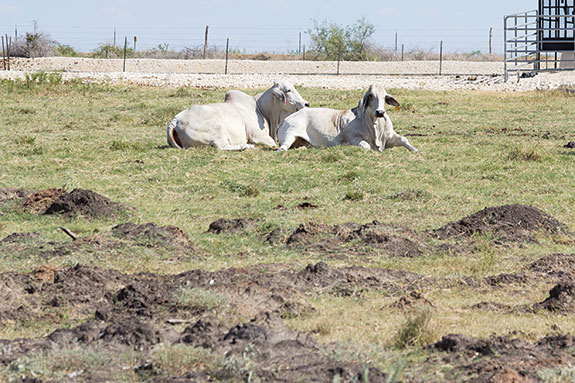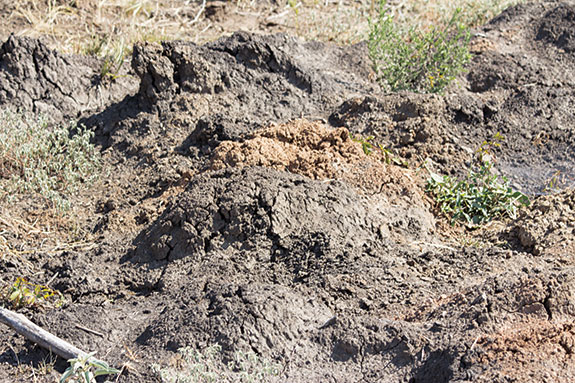Efficiency has become an increasingly important part of a manager’s vocabulary. As costs rise, controlling lost value is a good goal for many operations.
In some cases, challenges to the game plan could be weather, disease outbreak or a four-legged critter that will negatively impact the operation.
Feral hogs were brought to this country by Spanish explorers and were once a beneficial part of the food chain for early Americans, but as time went by this early staple has become a large problem for some landowners.
“Feral swine is really not the right word. Wild pigs is a more appropriate term to describe these animals. The feral hog is just part of the equation,” says Billy Higginbotham, extension wildlife specialist at Texas A&M AgriLife Extension.
At one time, wild hogs were confined to several states. Different reasons have caused populations to migrate and change over time.
“Forty-six of the lower 48 states have wild pig populations,” Higginbotham says. “Some of these populations are due to their popularity for hunting and illegal clandestine efforts were used to move them to different areas.
There is not enough predation pressure to control populations. A few small pigs less than 20 pounds could be taken, but other than human pressure there is not much to control populations.”
“We have had wild pigs in Texas since the 1600s and from 2006 to 2010, our population doubled,” says Mike Bodenchuk, state director for USDA Wildlife Services.
“We went 400 years where we hardly noticed them to 21 percent growth annually for four years. It backed off with the drought, but not as much as you would think.”
Damage from wild pigs can come in a variety of ways once populations congregate in certain areas. Crop losses and property damages are things that come to mind for most, but losses due to disease could also impact the operation.
As humans spread out, these critters can have an adverse effect on non-agricultural property as well.
 “Most agriculture damage is to improved pastures, winter annuals and to high-value crops like peanuts,” says Higginbotham.
“Most agriculture damage is to improved pastures, winter annuals and to high-value crops like peanuts,” says Higginbotham.
“They can also cause cattle to test false positive for brucellosis, which could cost a rancher a lot of time and money re-testing the herd.
You don’t think about swine/vehicle collisions or their rooting behavior tearing up golf courses, cemeteries or private landscapes.
Probably the biggest threat is bacteria loading in the waterways.
A lot of species can contribute to that, but wild pigs are a specific threat because they migrate up and down waterways. They need water to drink and wallow to cool off.”
“Wild hogs impact every system there is. They can spread diseases to domestic livestock and impact watersheds,” Bodenchuk says. “It’s our job to help the landowner control these populations.”
Behavioral patterns and different age groups sometimes throw landowners off if there is a problem or not. Each day could cost a lot of money in the wake of a wild pig epidemic.
“Some of the damage we see is age-specific. Little pigs don’t root. You could have two sows, each with a litter of eight, and see very little evidence.
 All of a sudden, in nine months, you have 18 rooting.
All of a sudden, in nine months, you have 18 rooting.
If 10 pigs live in a four-square-mile area, it’s sometimes hard to notice them until you plant wheat or ryegrass, then it seems like you have a population explosion on your hands,” Bodenchuk says.
“Population growth is slow the first 24 months; after that time it can get out of hand real quickly.
Wild pigs have three litters every two years.
From two sows, in 33 months with no mortality, you could be looking at 1,400 pigs.”
“You can have a considerable wild pig population and never see one in the daylight. They are nocturnal; very rarely will you see them, but you will see the evidence,” Higginbotham says.
“You have to know what you’re looking for; the easiest way to prevent damage is to get after it before it starts.
You should be able to see some sign: tracks, wallow in the mud or other damage. Enact those control methods at first sign. We have four legal methods of control in Texas: snaring, trapping, shooting and catch dogs.”
Today, labor resources are limited on most operations. Utilizing available technology could help landowners save time in the fight against wild pig damage. Many landowners may not have the tools or know-how to get the job done.
“We have to get information to the landowners so they can be successful,” Higginbotham says. “Our goal is to help them control populations as economically and efficiently as they can.
A $100 game camera will reduce the amount of time it takes trying to locate wild pigs and determine their behavior patterns. Never set up a trap until you know where the pigs are and how many you are dealing with.
“Most landowners get frustrated because they are not using the best methods of control. Corral traps are more successful, but most still use the small box-type traps because they are portable.
Corral traps aren’t very portable, and if damage continues you may have to re-bait that trap, build a new one or move the existing one because of behavioral changes.”
According to Bodenchuk, Wildlife Services is a service-based program and will only come on the property with a landowner invitation where the worst problems exist.
“We are funded by a cooperative effort to help control wild pig populations. This allows the landowners to help themselves,” he states. “Our goal is to eliminate 90 percent of that population in those areas. If we just eliminate 50 percent, the problem will be back in six months.”
Control methods may sound harsh to opponents of agriculture. These methods are used to help landowners keep damage costs low and protect their property. Efficiency is again a key word for those involved.
“Obviously, our benefit/cost analyses get higher with more valuable crops; range land is the lowest at about a $3 return per $1 spent. Rice and peanuts can get as high as $14 or $15 dollars per $1 spent.
Overall, we average around $11 return per $1 spent. Our research shows if we can eliminate numbers this year, it will also impact next year’s crops too, so our estimates are pretty conservative,” Bodenchuk says.
“Just because we night shoot them in a corn field doesn’t mean they aren’t living in the pasture next door. Aerial shooting from a helicopter is most economical in controlling populations or getting them back to manageable numbers. Our effort has to be two-pronged, though. We have to educate the landowner through outreach programs to control that population when we’re gone.”
Utilizing control methods in the proper manner could also turn into a revenue source for some landowners. Generating revenue from wild pigs is a common theme.
“A lot of landowners manage deer or other wildlife for recreational purposes. Wild pigs have no season, and there should be little tolerance for wild pigs in this scenario, which could lead to another source of revenue,” Higginbotham says.
“The number of pigs you’re dealing with will tell you how big to build your trap. Texas has over 90 buying stations that will buy live wild pigs. Trap design will change a little if landowners plan to take live pigs to one of the buying stations. These traps will need to be designed where landowners can load pigs easily onto a trailer.”
Some forms of control protect property, such as golf courses, orchards, vineyards or high-value crops, but do little to decrease populations.
These methods of control also come with an expense to landowners and may not always work.
“Mesh fencing is being increasingly used to try and keep wild pigs out. There is a cost in putting that fence up to keep wild pigs off certain properties and reduce access to protect high-value areas,” Higginbotham says.
“This will limit access, but it does nothing to change wild pig populations, and no fence is a 100 percent guarantee to keep them out.”
Like most management tools, continued education likely means the difference between success and failure. Utilizing up-to-date research and control methods could keep numbers manageable for landowners.
Certain challenges exist with every situation, and landowners must be persistent in the effort to control wild pig populations.
“It is amazing the impact on populations a concentrated effort can have,” Bodenchuk says. “We take out about 25,000 wild pigs a year, which is 1 percent of the Texas population. We’re not going to eliminate them but can control problem areas.
There are several methods to control populations; we have to do our best to get the landowners the information they need to keep populations low.”
“Not all control methods work in all areas. Every situation is different, and sometimes it takes a combination of control methods to get the job done. It takes a constant effort in certain areas,” Higginbotham says.
“When we continue to put pressure on populations or change their behavior and cause them to move on, we can decrease the damage on a value basis by two-thirds. When we reduced the number of pigs with legal control methods, economic impact went down from $2.2 million to $750,000. We have 2.6 million wild pigs in the state; we’re not going to eliminate them, but with education and proper control methods, we can manage damage.” ![]()
Feral hogs
- Feral hogs were first introduced into the U.S. in the 1500s and are very prominent in the Southeastern part of the U.S. A large population also exists in Texas and California.
- Wild pig populations are in 46 of the 48 contiguous states. Many may have been transported to new territory illegally for recreational purposes. In 1982, only 17 states reported wild pig populations.
- Wild pigs are opportunistic omnivores and can be very destructive.
- Wild pig populations can grow rapidly because of their ability to reproduce quickly and lack of natural predators.
- Many landowners have turned wild pigs into a revenue source, either through hunting or trapping live pigs and taking them to approved buying stations.Some restaurants, foodies and organic/free range philosophies treat this item as a delicacy, making it in high demand for certain demographics. From 2004 to 2009, 460,000 wild pigs were processed for human consumption in the state of Texas alone.
- In Texas, wild pigs are reported to cause nearly $52 million in agricultural damage, approximately $7,500 per land owner.
- In Texas, 29 percent of the population is harvested annually. Ninety-two percent of this is removed through trapping and shooting. Of that, 11 percent is recreational hunting.
- Education efforts will help landowners manage populations. Local extension agents are a good place to start looking for help. Private trappers are also available in some areas to come on your property.
PHOTOS
TOP: This picture shows a small sounder of feral swine defending corn from a deer feeder against encroaching cattle. Every time the cattle come in to attempt to feed, the lead sow (white) would charge to a distance perfect for aerosol disease transmission. Photo courtesy of RD Wildlife Management.
MIDDLE/BOTTOM: Feral swine, or wild pigs as they are known, create crop losses and pasture damage like what’s seen in these shots from a Navasota, Texas cattle facility. Photos courtesy of Progressive Cattleman staff.







